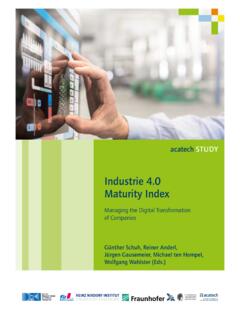Transcription of The Art of Coding and Thematic Exploration in Qualitative ...
1 45 International Management Review Vol. 15 No. 1 2019 The Art of Coding and Thematic Exploration in Qualitative Research michael Williams School of Business and Management, Thomas Edison State University, Trenton, NJ, USA Tami moser Department of Pharmaceutical Sciences, College of Pharmacy, Southwestern Oklahoma State University, Weatherford, OK, USA [Abstract] Coding in Qualitative research is comprised of processes that enable collected data to be assembled, categorized, and thematically sorted, providing an organized platform for the construction of meaning. While Qualitative research orientations differ theoretically and operationally relative to managing collected data, each employs a method for organizing it through Coding data.
2 Coding methods employ processes that reveal themes embedded in the data, in turn suggesting Thematic directionality toward categorizing data through which meaning can be negotiated, codified, and presented. Coding is a key structural operation in Qualitative research, enabling data analysis and successive steps to serve the purpose of the study. This paper focuses on identifying, defining, and describing the Coding techniques available to researchers, the function of each stage in the Coding method, the iterative review process associated within the Coding cycle, and the transition from codes to themes toward constructing meaning from the data. In addition, it references/provides examples of manual Coding practices and identifies Qualitative research software available for Coding .
3 [Keywords] Coding ; Thematic Exploration ; Qualitative research Not everything that counts can be counted, and not everything that can be counted counts. ----Albert Einstein Introduction Qualitative research provides opportunities to locate the genesis of a phenomenon, explore possible reasons for its occurrence, codify what the experience of the phenomenon meant to those involved, and determine if the experience created a theoretical frame or conceptual understanding associated with the phenomenon. While quantitative research methods seek to count and provide statistical relevance related to how often a phenomenon occurs and then generalize the findings, Qualitative research methods provide opportunities to delve into the phenomenon and determine its meaning while and after it occurs.
4 Regardless of the research approach, the methodology employed for data collection and organization must be clear and repeatable, leading to and enabling data analysis. As in any research design, if its data collection and organization methods lack rigor, analysis can be impeded, in turn minimizing the value of outcomes. This approach supports the evolution of constructing meaning from the data, in turn enabling contributions to the related literature and enhancing our understanding of the world. Context Authors writing about Qualitative research methods1 3 indicate that the evolution of Qualitative research has migrated through decades of methodological consolidation complemented by a concentration on procedural questions in a growing research practice (Flick, 2009, ).
5 Philosophical and methodological yields from this migration are the different orientations and procedures associated with conducting Qualitative research. Given the plethora of Qualitative research formats available, researchers need to decide which methodological approach will most effectively 46 International Management Review Vol. 15 No. 1 2019 enable their study. Qualitative research is not based on a unified theoretical and methodological concept. The variety of approaches results from different developmental lines in the history of Qualitative research, which evolved partly in parallel and partly in sequence (Flick, 2009, p. 306). As Qualitative research has evolved and methodologies for collecting and organizing data have matured, specific strategies and structures for managing data in these areas have emerged and become common practice.
6 A key data organizing structure in Qualitative research is Coding . A code in Qualitative inquiry is most often a word or short phrase that symbolically assigns a summative, salient, essence-capturing, and/or evocative attribute for a portion of language-based or visual data (Saldafia 2009, ). Initially, Coding began as a progressive three-part schema; First, Second and Third level Coding guided by the formula from codes and categories to theory (Saldafia 2009, p. 4). From these early Coding strategies, additional Coding strategies evolved associated with the emergent types of Qualitative research methods ( , Phenomenological, Grounded Theory). This paper reviews the Coding strategies associated with Qualitative research using Grounded Theory method as an example for demonstrating the uses of the three-step Coding process; open, axial, and selective Coding .
7 Brief Historical Perspectives The Ground Theory Method (GTM) of Qualitative research emerged from the work of Barney Glaser and Anselm Strauss, aligned with the Chicago School of symbolic interactionism, which rose to prominence in the early part of the twentieth century (Glaser, 1967). In their seminal work The discovery of grounded theory: Strategies for Qualitative research, the authors suggested a pluralist and flexible approach to data Coding (Strauss, 1998). Our principal aim is to stimulate other theorists to codify and publish their own methods for generating theory and join us in telling those who have not yet attempted to generate theory that it is not a residual chore in this age of verification (Glaser, 1967.)
8 P. 8). While encouraging researchers towards a pluralist and flexible orientation to Coding and to original methods for generating theory, the reference to not a residual chore in this age of verification is significant, as it is a reference to the quantitative research as being the dominant research method of the time. This initial philosophic frame suggests that researchers employing Qualitative research methods, in this case GTM, should not engage in data organizing strategies indiscriminately. Instead, they should apply guiding principles that intentionally enable them to codify and publish their own methods for generating theory (Strauss, 1998, ). The focus on articulating a clear methodological framework that is both rigorous and able to be replicated, suggests a researcher engaged in Qualitative research is using a viable research method.
9 The pluralistic nature of GTM [does not] mean that researchers can do pretty much whatever they are certain principles about which grounded theory, proponents concur and as long as these principles are kept in mind, the details of the procedure can be modified to suit a researcher s needs (Larossa, 2005, p. 840). In this context, the GTM was one of the first Qualitative methods to have a systematic approach for codifying and categorizing data in order to generate theory. As a result, researchers were provided with the methodological means to construct meaning from research findings through a three-phase Coding method. The Coding method enabled a progressive and verifiable mechanism for establishing codes, their origins, relationships to each other, and integration resulting in themes used to construct meaning.
10 The construction of meaning from collected data is the result of the progressive data Coding process. In order for researchers to generate theory, researchers need to evidence employing an analytic approach and rationale methodological decisions. Through explicating their decisions, grounded theorists gain control over their subject matter and their next analytic or methodological move. The construction of the process, as well as the analytic product, is emergent theory (Charmaz, 2008, p. 408). Open, axial and selective Coding of collected data results in the creation of theory, leading the researcher to construct deeper theoretical meaning. This method of Coding provides researchers with nuanced access to study informants thoughts, perspectives, and reactions to study topics.





